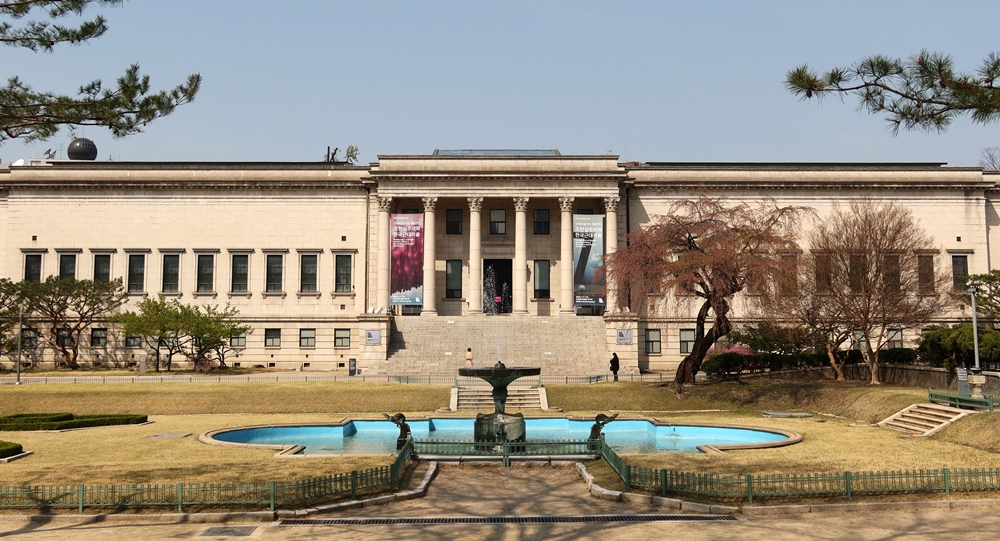
A visitor on April 16 looks at a work by Korean Japanese artist Kim Chongnam (Hideo Manabe) at a news conference for the exhibition "Surrealism and Korean Modern Arts" at the Deoksugung Palace branch of the National Museum of Modern and Contemporary Art, Korea in Seoul's Jung-gu District. (Charles Audouin)
By Charles Audouin
Surrealism is an art movement that dreams of liberation from oppression of the human spirit through the pursuit of resistance, disharmony, marvel and humor.
Originating in France after World War I, this revolutionary movement seeks to resolve important issues in life. Though it spread worldwide in the late 1920s, it failed to catch on in Korea because of colonialism, war and national division.
Certain domestic artists, however, did explore Surrealism during their lifetimes. The exhibition "Surrealism and Korean Modern Arts," which opened on April 17 at the Deoksugung Palace branch of the National Museum of Modern and Contemporary Art, Korea (NMCA), features six painters who expressed their inner landscapes through their unique ways of contemplation.

"My Landscape" is a 1980 oil painting by Korean Japanese artist Kim Chongnam (Hideo Manabe). (NMCA)
Born in Sancheong-gun County, Gyeongsangnam-do Province, in 1914, artist Kim Chongnam later became a naturalized Japanese citizen and worked under the name Hideo Manabe.
He usually drew organisms in nature such as plants, animals and insects, but his works went beyond simple portrayal. Many of his paintings featured strange creatures hiding inside plants or those that were combinations of humans and birds or plants.
To prevent discrimination against ethnic Koreans in Japan, Kim told his two sons on his deathbed of his Korean ethnicity. His paintings reflect his confusion over identity and conflict caused by anxiety.

These works by artist Kim Ukkyu are displayed at the exhibition "Surrealism and Korean Modern Arts" at the Deoksugung Palace branch of the National Museum of Modern and Contemporary Art, Korea. (Charles Audouin)
Born in Hamheung, Hamgyeongnam-do Province, in present-day North Korea, Kim Ukkyu left his family to go to the southern half of the Korean Peninsula alone during the Jan. 4 Retreat, when United Nations forces withdrew from Seoul and other areas after North Korean forces recaptured Seoul.
His works reflect the anxiety stemming from the state between dreams and reality and life and death, usually through eccentric creatures hidden in surrealist spaces and humans with distorted or elongated appearances or those combined with bird figures.
This artist left behind about 400 works, mostly unsigned or untitled. His first solo exhibition came after his death in 1990.

On the left is "Cactus (Life)" (1977) by Kim Chongha and on the right is "Fantasy of Peninsular" by Park Gwangho in the 1970s. (NMCA)
Kim Chongha and Park Gwangho were not limited by modernization of tradition or exploration of national identity, two themes stressed in the nation's modern and contemporary arts. They also portrayed personal and intimate desires and erotic fantasies.
Kim drew sensual female nudes with unrealistically glowing and pure white skin against the backdrop of a dark interior. Park through his series of works delicately touched on repressed passion and materialistic desire.

The works of Kim Younghwan are on display at the exhibition "Surrealism and Korean Modern Arts" at the Deoksugung Palace branch of the National Museum of Modern and Contemporary Art, Korea. (Charles Audouin)
Kim Younghwan and Shin Youngheon reinterpreted the country's reality of war and division in the 20th century, capturing new worlds on canvas.
Kim expressed the love from coexistence of humans and nature by using motifs like bulls, horses and birds. Shin created bizarre images of dehumanized cityscapes combined with human figures.
Ending on July 6, the exhibition displays some 230 works by 50 surrealist artists. Admission is KRW 2,000 per person excluding that for Deoksugung Palace (KRW 1,000).
caudouin@korea.kr
Deoksugung Palace branch of NMCA (Charles Audouin)
The Deoksugung Palace branch of the NMCA was opened in 1998 at the west wing of the palace's Seokjojeon Hall. Visitors can see other nearby tourist attractions such as Sejong Center for the Performing Arts, Jeongdong Park, Seoul Museum of Art and Namdaemun Market. It is close to exit 1 of City Hall Station (Seoul Subway Lines 1 and 2).
Most popular
- 2 Egyptian sisters reflect on 10 years as Honorary Reporters
- 'When Life Gives You Tangerines' actor to promote Hanbok
- Korean content on Netflix in 2024 ranked 2nd in global views
- Social influencer teaches Korean to world via short videos
- Actor Bae Doona's first romcom in decade to hit theaters in May
